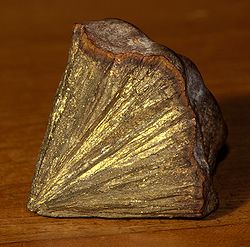BISMUTHINITE

Bismuthinite is a mineral consisting of bismuth sulfide (Bi2S3). It is an important ore for bismuth. The crystals are steel-grey to off-white with a metallic luster. It is soft enough to be scratched with a fingernail and rather dense.
Bismuthinite forms a series with the lead, copper, bismuth mineral aikinite
REALGAR

Realgar, α-As4S4, is an arsenic sulfide mineral. It is a soft, sectile mineral occurring in monoclinic crystals, or in granular, compact, or powdery form, often in association with the related mineral, orpiment (As2S3). It is orange-red in colour, melts at 320 °C, and burns with a bluish flame releasing fumes of arsenic and sulfur. Realgar is soft with a Mohs hardness of 1.5 to 2 and has a specific gravity of 3.5. Its molecular weight is 106.99. Its streak is orange colored. Realgar has a sub-metallic luster. Hmm... make a stockpile of Reakgar near your entrance, pout magma on it when the Goblins come...
ORPIMENT

Orpiment is an orange to yellow mineral that is found worldwide, and occurs as a sublimation product in volcanic fumaroles, low temperature hydrothermal veins, hot springs and as a byproduct of the decay of another arsenic mineral, realgar. It is often found in association with realgar. It takes its name from the Latin auripigmentum (aurum − gold + pigmentum − pigment) because of its deep yellow color.
STIBNITE

Stibnite, sometimes called antimonite, is a sulfide mineral with the formula Sb2S3. It forms grey orthorhombic crystals of hardness 2. It is the most important source for the rare metaloid antimony. Antimony (pronounced /ˈæntɪmoʊni/ (US), /ˈæntɪməni/ (UK)) is a chemical element with the symbol Sb (Latin: stibium, meaning "mark") and atomic number 51. A metalloid, antimony has four allotropic forms. The stable form of antimony is a blue-white metalloid. Yellow and black antimony are unstable non-metals. Antimony is used in flame-proofing, paints, ceramics, enamels, a wide variety of alloys, electronics, and rubber.
MARCASITE

The mineral marcasite, sometimes called white iron pyrite, is iron sulfide (FeS2). Marcasite is often mistakenly confused with pyrite, but marcasite is lighter and more brittle. Specimens of marcasite often crumble and break up due to the unstable crystal structure, and it is this crystal structure that is the main difference between marcasite and pyrite. Though marcasite has the same chemical formula as pyrite, it crystallizes in a different crystal system, thereby making it a separate mineral. In jewelry, pyrite used as a gem is improperly termed "marcasite". True marcasite is never used as a gem, due to its brittle and chemically unstable structure.
SYLVITE

Sylvite is potassium chloride (KCl) in natural mineral form. It forms crystals in the isometric system very similar to normal rock salt, halite (NaCl). (The two are, in fact, isomorphous. [3] Sylvite is colorless to white with shades of yellow and red due to inclusions. It has a Mohs hardness of 2.5 and a specific gravity of 1.99. It has a refractive index of n=1.490) [4]. Sylvite has a salty taste with a distinct bitterness. (What?)
Sylvite is one of the last evaporite minerals to precipitate out of solution. As such, it is only found in very dry saline areas. Its principal use is as a potassium fertilizer.
CRYOLITE

Cryolite (Na3AlF6, sodium hexafluoroaluminate) is an uncommon mineral of very limited natural distribution. It is mostly identified with the once large deposit at Ivigtût on the west coast of Greenland, which ran out in 1987.
It was historically used as an ore of aluminium and later in the electrolytic processing of the aluminium rich oxide ore bauxite (itself a combination of aluminium oxide minerals such as gibbsite, boehmite and diaspore). The difficulty of separating aluminium from oxygen in the oxide ores was overcome by the use of cryolite as a flux to dissolve the oxide mineral(s). Cryolite itself melts below 900°C (1173 Kelvin) and can dissolve aluminium oxides sufficiently well to allow easy extraction of the aluminium by electrolysis. Considerable energy is still required for both heating the materials and the electrolysis, but it is much more energy-efficient than melting the oxides themselves. Now, as natural cryolite is too rare to be used for this purpose, synthetic sodium aluminium fluoride is produced from the common mineral fluorite for this purpose.
PERICLASE

Periclase occurs naturally in contact metamorphic rocks and is a major component of most basic refractory bricks. It is a cubic form of magnesium oxide (MgO).
The old term for the mineral is magnesia. Stones from the Magnesia region in ancient Anatolia contained both magnesium oxide and hydrated magnesium carbonate as well as iron oxides (such as magnetite). Thus these stones, called Stones from Magnesia in antiquity, with their unusual magnetic properties were the reason the terms magnet and magnetism were coined. Periclase is usually found in marble and pure periclase is colorless.
28 more minerals left. Then, mebby I'll explain the dirt types.
[ May 03, 2008: Message edited by: PTTG?? ]

 Author
Topic: Learning about all our Dwarf Fortress Rocks! (Read 53354 times)
Author
Topic: Learning about all our Dwarf Fortress Rocks! (Read 53354 times)

